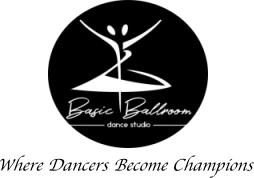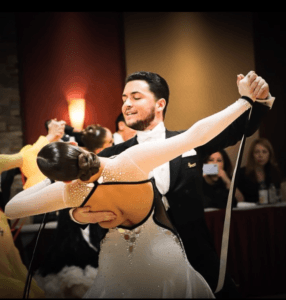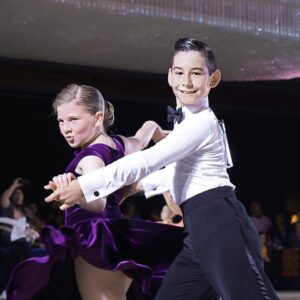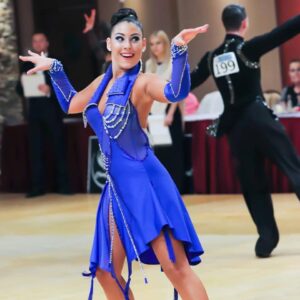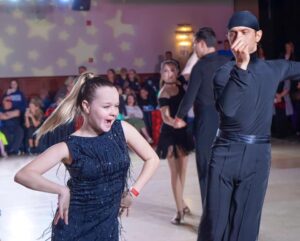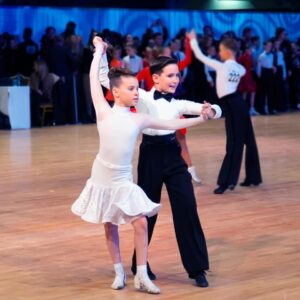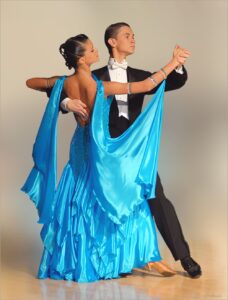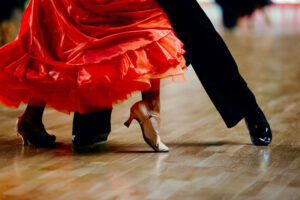Latin
- Cha Cha (Latin)
- Samba (Latin)
- Rumba (Latin)
- Paso Doble (Latin)
- Jive (Latin)
Ballroom
- Waltz (Ballroom)
- Tango (Ballroom)
- Viennese Waltz (Ballroom)
- Foxtrot (Ballroom)
- Quickstep (Ballroom)
Rhythm
- Cha Cha (Rhythm)
- Rumba (Rhythm)
- Swing (Rhythm)
- Bolero (Rhythm)
- Mambo (Rhythm)
Smooth
- Waltz (Smooth)
- Tango (Smooth)
- Foxtrot (Smooth)
- Viennese Waltz (Smooth)
International Latin
1. Cha Cha
A continual, flirtatious game of “cat and mouse” – the International Cha Cha has Cuban roots, and is known for its breaking action on count “2” (unique to Cha Cha, Rumba, and Mambo) and syncopated action on counts 4&1 (also counted as “cha cha cha”). Differentiating itself from the American Cha Cha, the International style is danced with a straight leg action throughout.
2. Samba
The Samba is a ballroom dance is inspired by the Brazilian carnival dances. While Brazilian Samba is traditionally danced alone, the International Latin Samba derives rhythmic actions and high energy from its Brazilian ancestry. Samba is notably a “bouncy” dance, known for intricate combinations of timings and beat values.
3. Rumba
The International Rumba is the slowest International Latin dance in terms of music, however, it showcases alternating timings to depict fast moments within a slow dance. Known as the dance of love, the Rumba is crowd favorite, often telling a romantic story between two people. Unlike the American Rumba, the International style is danced with a straight leg action, likened to the International Cha Cha.
4. Paso Doble
Much to people’s surprise, the Paso Doble originated in France, and many named figures within this dance are in French, such as “apel,” meaning “call to action” (this is a weight replacement that involves articulation of the entire foot with the ground, typically creating a stomping sound). A captivating dance style, the Paso Doble is based on the story of the Spanish Bullfight, with partners encapsulating the personalities of the Spanish Bullfighter (Matador) and either a Matador’s Cape or Spanish Dancer.
5. Jive
It’s party time! International Latin concludes with the joyful and energetic Jive. The Jive is a dance built from multiple styles of Swing: East Coast, West Coast, Lindy Hop, Jitterbug, and more. Characterized by quick feet and fun tricks, the Jive often has a crowd on their feet cheering.
International Ballroom
6. Waltz
The classic, elegant, International Waltz is the quintessential, “ballroom dance” (think, Cinderella!) Known for its characteristic “123,” the Waltz is danced in a closed hold (partners do not break their frame and remain connected) from start to finish. This is a unique element to all International Ballroom dances.
7. Tango
The fiery and passionate Tango features staccato actions and powerful leg movements. Dancers do not have “body rise” within this dance, so it appears flatter and more linear across the dance floor. These features, along with a varied dance position and footwork, present interesting technical differences between the Tango and other International Ballroom dances.
8. Viennese Waltz
Originating in Vienna, Austria, the Viennese Waltz is significantly faster-paced than the Waltz (often referred to as the “Slow Waltz” for this reason). The Viennese Waltz is only comprised of seven figures, therefore dancers spend a lot of time focusing on the creation of the same full, voluminous movements that seem to race around the dance floor.
9. Foxtrot
The jazzy foxtrot takes on a smoother appearance within the International Ballroom style, ebbing and flowing like waves across the shore. Intricate rise and falls are created by decisive footwork that anecdotally awarded Foxtrot the title of the most difficult Ballroom dance.
10. Quickstep
Leaps, kicks, and running down the floor, all while being connected to another person? In the Quickstep, dancers seem to play Tetris while dancing and navigating in and out of “traffic” on the floor. It’s a true talent.
American Rhythm
11. Cha Cha
The American Rhythm Cha Cha is danced from a bent leg to a straight leg, a unique element to the American style. Figures between the the International and American Cha Chas are similar, but tend have different names and are danced with a slightly different technique.
12. Rumba
The American Rumba is a mixture of International Cha Cha and Rumba. This dance allows for faster speed and steps than its International Rumba counterpart. Danced with a bent-to-straight leg action, the American Rumba is upbeat with strongly accentuated hip actions known as “Cuban Action.”
13. Swing
The American, otherwise known as “East Coast” Swing, originated in the North American East Coast in the early 20th century. While it is more grounded, slower, and less “bouncy” than the Jive, it has a fun and invigorating energy, making it a definite crowd pleaser!
14. Bolero
The Bolero is a unique dance that combines aspects of the American Waltz and International Rumba. While these two dances sound completely different, they meld to create a dance with excellent flow. Think of Bolero as similar to Rumba, but with rise and fall!
15. Mambo
Time for some Cuban Mambo—which means time for a fiesta! Featuring shimmies and shakes, this dance usually breaks on count two and is related to Salsa and the Cumbia. When danced within a social dance setting, there are many interpretations, depending on the country.
American Smooth
16. Waltz
The American Style allows dancers to break closed frame position and combines International Styles with elements of Jazz and Contemporary. The Smooth Waltz moves seamlessly from closed position, to shadow, to side-by-side, and numerous other proximities and holds, while following the traditional “123” beat.
17. Tango
The eccentric and passionate Smooth Tango merges the International Style with classic Argentinian Tango elements. Staccato actions, straight lines, sharp changes are typical of this dance.
18. Foxtrot
Made famous by Harry Fox of New York City, the Foxtrot features elements of jazz, smooth transitions, and charming characters. A slightly faster timing than the International Foxtrot allows for a more upbeat version of the dance. When thinking about the Smooth Foxtrot, think Fred Astaire and Ginger Rogers—bright energy and enthusiasm!
19. Viennese Waltz
The Smooth Viennese Waltz is a billowy, emotional, and fast-paced dance to round out the four American Smooth Style dances. Significantly slower than the International Viennese Waltz, it allows dancers to evolve throughout a multitude of dance positions and styling for optimal storytelling.
